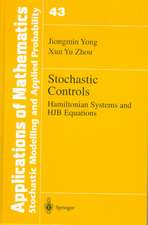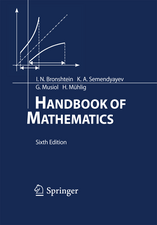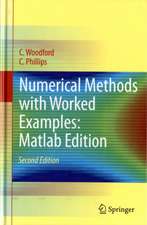The Boltzmann Equation and Its Applications: Applied Mathematical Sciences, cartea 67
Autor Carlo Cercignanien Limba Engleză Hardback – 18 dec 1987
| Toate formatele și edițiile | Preț | Express |
|---|---|---|
| Paperback (1) | 1388.68 lei 43-57 zile | |
| Springer – 28 oct 2012 | 1388.68 lei 43-57 zile | |
| Hardback (1) | 1232.89 lei 43-57 zile | |
| Springer – 18 dec 1987 | 1232.89 lei 43-57 zile |
Din seria Applied Mathematical Sciences
- 13%
 Preț: 426.94 lei
Preț: 426.94 lei - 13%
 Preț: 426.46 lei
Preț: 426.46 lei - 13%
 Preț: 427.63 lei
Preț: 427.63 lei - 9%
 Preț: 1728.59 lei
Preț: 1728.59 lei - 24%
 Preț: 906.80 lei
Preț: 906.80 lei - 23%
 Preț: 659.07 lei
Preț: 659.07 lei -
 Preț: 375.65 lei
Preț: 375.65 lei - 18%
 Preț: 909.47 lei
Preț: 909.47 lei - 18%
 Preț: 795.02 lei
Preț: 795.02 lei - 18%
 Preț: 950.52 lei
Preț: 950.52 lei - 15%
 Preț: 645.47 lei
Preț: 645.47 lei - 20%
 Preț: 755.49 lei
Preț: 755.49 lei -
 Preț: 382.67 lei
Preț: 382.67 lei - 24%
 Preț: 808.06 lei
Preț: 808.06 lei -
 Preț: 452.62 lei
Preț: 452.62 lei -
 Preț: 190.23 lei
Preț: 190.23 lei -
 Preț: 399.12 lei
Preț: 399.12 lei - 18%
 Preț: 966.90 lei
Preț: 966.90 lei - 15%
 Preț: 643.48 lei
Preț: 643.48 lei - 15%
 Preț: 528.80 lei
Preț: 528.80 lei -
 Preț: 413.15 lei
Preț: 413.15 lei -
 Preț: 390.25 lei
Preț: 390.25 lei - 18%
 Preț: 736.01 lei
Preț: 736.01 lei - 18%
 Preț: 1411.05 lei
Preț: 1411.05 lei - 15%
 Preț: 711.21 lei
Preț: 711.21 lei -
 Preț: 395.47 lei
Preț: 395.47 lei - 18%
 Preț: 1017.26 lei
Preț: 1017.26 lei -
 Preț: 403.15 lei
Preț: 403.15 lei - 18%
 Preț: 1130.14 lei
Preț: 1130.14 lei - 18%
 Preț: 1134.87 lei
Preț: 1134.87 lei - 18%
 Preț: 1329.00 lei
Preț: 1329.00 lei - 18%
 Preț: 1129.65 lei
Preț: 1129.65 lei - 18%
 Preț: 1140.71 lei
Preț: 1140.71 lei
Preț: 1232.89 lei
Preț vechi: 1503.53 lei
-18% Nou
Puncte Express: 1849
Preț estimativ în valută:
235.99€ • 256.42$ • 198.36£
235.99€ • 256.42$ • 198.36£
Carte tipărită la comandă
Livrare economică 21 aprilie-05 mai
Preluare comenzi: 021 569.72.76
Specificații
ISBN-13: 9780387966373
ISBN-10: 0387966374
Pagini: 455
Ilustrații: XIII, 455 p.
Dimensiuni: 155 x 235 x 29 mm
Greutate: 0.88 kg
Ediția:1988
Editura: Springer
Colecția Springer
Seria Applied Mathematical Sciences
Locul publicării:New York, NY, United States
ISBN-10: 0387966374
Pagini: 455
Ilustrații: XIII, 455 p.
Dimensiuni: 155 x 235 x 29 mm
Greutate: 0.88 kg
Ediția:1988
Editura: Springer
Colecția Springer
Seria Applied Mathematical Sciences
Locul publicării:New York, NY, United States
Public țintă
ResearchCuprins
I. Basic Principles of The Kinetic Theory of Gases.- 1. Introduction.- 2. Probability.- 3. Phase space and Liouville’s theorem.- 4. Hard spheres and rigid walls. Mean free path.- 5. Scattering of a volume element in phase space.- 6. Time averages, ergodic hypothesis and equilibrium states.- References.- II. The Boltzmann Equation.- 1. The problem of nonequilibrium states.- 2. Equations for the many particle distribution functions for a gas of rigid spheres.- 3. The Boltzmann equation for rigid spheres.- 4. Generalizations.- 5. Details of the collision term.- 6. Elementary properties of the collision operator. Collision invariants.- 7. Solution of the equation Q(f,f) = 0.- 8. Connection between the microscopic description and the macroscopic description of gas dynamics.- 9. Non-cutoff potentials and grazing collisions. Fokker-Planck equation.- 10. Model equations.- References.- III. Gas-Surface Interaction and the H-Theorem.- 1. Boundary conditions and the gas-surface interaction.- 2. Computation of scattering kernels.- 3. Reciprocity.- 4. A remarkable inequality.- 5. Maxwell’s boundary conditions. Accommodation coefficients.- 6. Mathematical models for gas-surface interaction.- 7. Physical models for gas-surface interaction.- 8. Scattering of molecular beams.- 9. The H-theorem. Irreversibility.- 10. Equilibrium states and Maxwellian distributions.- References.- IV, Linear Transport.- 1. The linearized collision operator.- 2. The linearized Boltzmann equation.- 3. The linear Boltzmann equation. Neutron transport and radiative transfer.- 4. Uniqueness of the solution for initial and boundary value problems.- 5. Further investigation of the linearized collision term.- 6. The decay to equilibrium and the spectrum of the collision operator.- 7. Steady one-dimensionalproblems. Transport coefficients.- 8. The general case.- 9. Linearized kinetic models.- 10. The variational principle.- 11. Green’s function.- 12. The integral equation approach.- References.- V. Small and Large Mean Free Paths.- 1. The Knudsen number.- 2. The Hilbert expansion.- 3. The Chapman-Enskog expansion.- 4. Criticism of the Chapman-Enskog method.- 5. Initial, boundary and shock layers.- 6. Further remarks on the Chapman-Enskog method and the computation of transport coefficients.- 7. Free molecule flow past a convex body.- 8. Free molecule flow in presence of nonconvex boundaries.- 9. Nearly free-molecule flows.- References.- VI. Analytical Solutions of Models.- 1. The method of elementary solutions.- 2. Splitting of a one-dimensional model equation.- 3. Elementary solutions of the simplest transport equation.- 4. Application of the general method to the Kramers and Milne problems.- 5. Application to the flow between parallel plates and the critical problem of a slab.- 6. Unsteady solutions of kinetic models with constant collision frequency.- 7. Analytical solutions of specific problems.- 8. More general models.- 9. Some special cases.- 10. Unsteady solutions of kinetic models with velocity dependent collision frequency.- 11. Analytic continuation.- 12. Sound propagation in monatomic gases.- 13. Two-dimensional and three-dimensional problems. Flow past solid bodies.- 14. Fluctuations and light scattering.- References.- VII. The Transition Regime.- 1. Introduction.- 2. Moment and discrete ordinate methods.- 3. The variational method.- 4. Monte Carlo methods.- 5. Problems of flow and heat transfer in regions bounded by planes or cylinders.- 6. Shock-wave structure.- 7. External flows.- 8. Expansion of a gas into a vacuum.- References.- VIII. Theorems on theSolutions of the Boltzmann Equation.- 1. Introduction.- 2. The space homogeneous case.- 3. Mollified and other modified versions of the Boltzmann equation.- 4. Nonstandard analysis approach to the Boltzmann equation.- 5. Local existence and validity of the Boltzmann equation.- 6. Global existence near equilibrium.- 7. Perturbations of vacuum.- 8. Homoenergetic solutions.- 9. Boundary value problems. The linearized and weakly nonlinear cases.- 10. Nonlinear boundary value problems.- 11. Concluding remarks.- References.- References.- Author Index.















